On September 1, 2019, the United States Coast Guard (USCG) Cutter Stratton (WMSL 752) returned to the South China Sea from the Indian Ocean, and berthed at Sembawang Naval Base in Singapore. Since the USCGC Stratton (WMSL 752) leaved Australia for the South China Sea at the end of July, it has been engaged in intensive deployments and conducted joint exercises or training with Coast Guard from Indonesia, Malaysia, etc, during “Cooperation Afloat Readiness and Training (CARAT) Thailand 2019” as well as “Maritime Training Activity Malaysia 2019 (MTA 2019) ”.
The USCGC Stratton (WMSL 752) is among the second batch of USCG vessels deployed to West Pacific in 2019. The USCGC Bertholf (WMSL 750) took the lead while departing from Alameda, California on January 20 for a six-month mission in the West Pacific region, followed by two coast guard vessels in the second batch: the USCGC Stratton (WMSL 752) and the USCGC Mellon (WHEC 717) departed from the US in June. Notably, a USCG HC-130H maritime patrol aircraft (tail number 1720) arrived at the Misawa Air Base, Japan in late June and was then deployed to Guam.
Note: the activities in the diagrams and charts are sorted out from Automatic Identification System (AIS) by SCSPI.
I. Deployments and Activity Maps of Three USCG Vessels in West Pacific
1. USCGC Bertholf (WMSL 750)
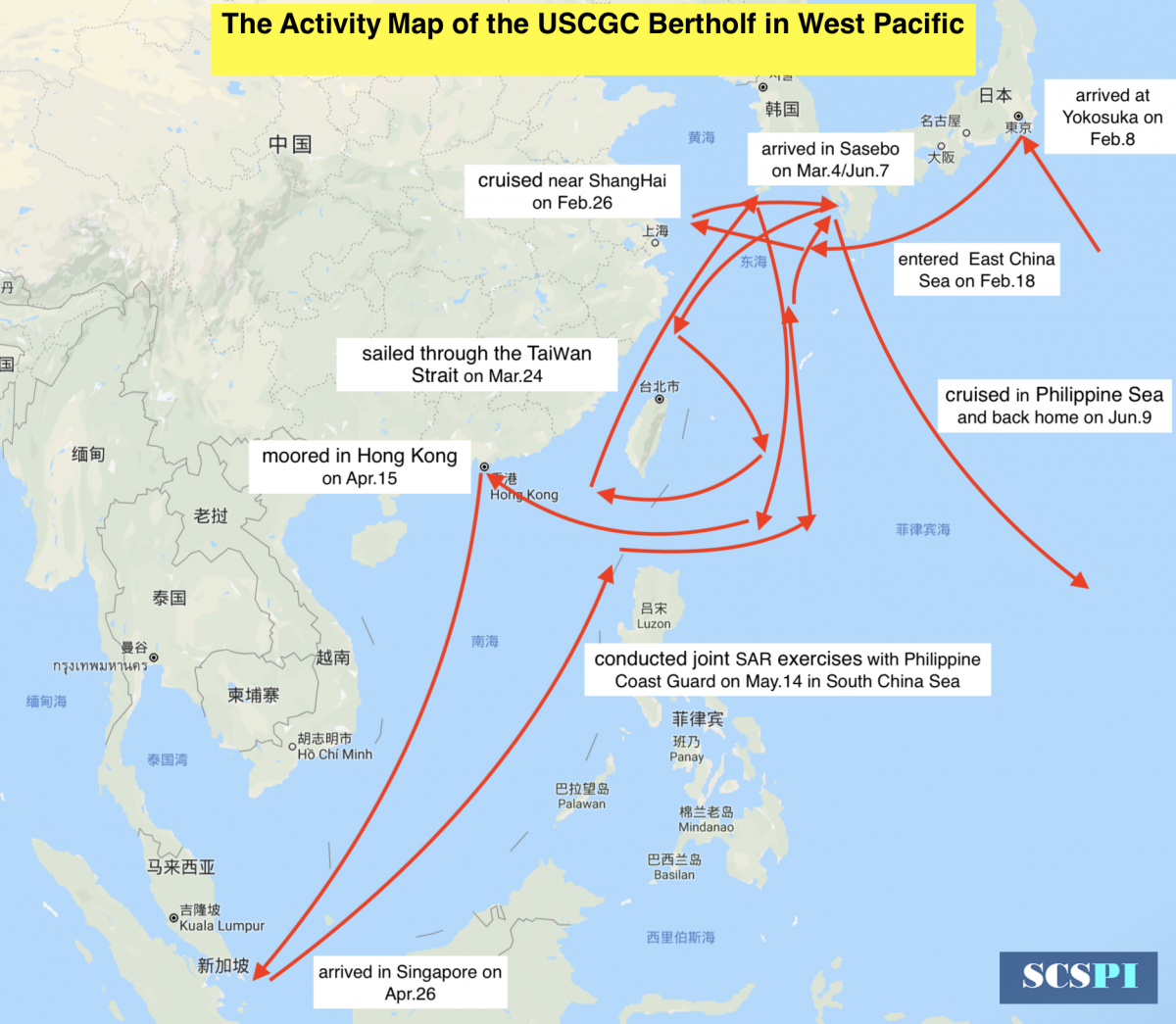
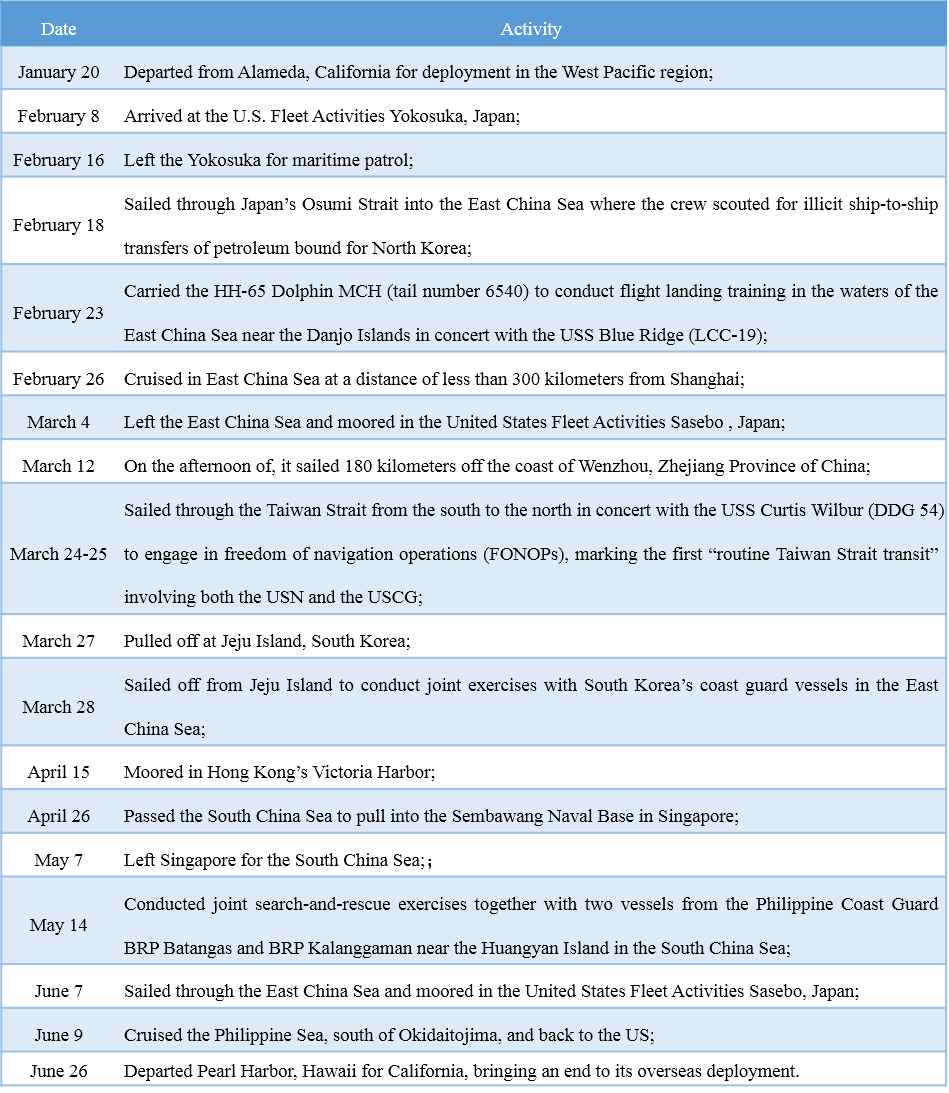
2. USCGC Stratton (WMSL 752)
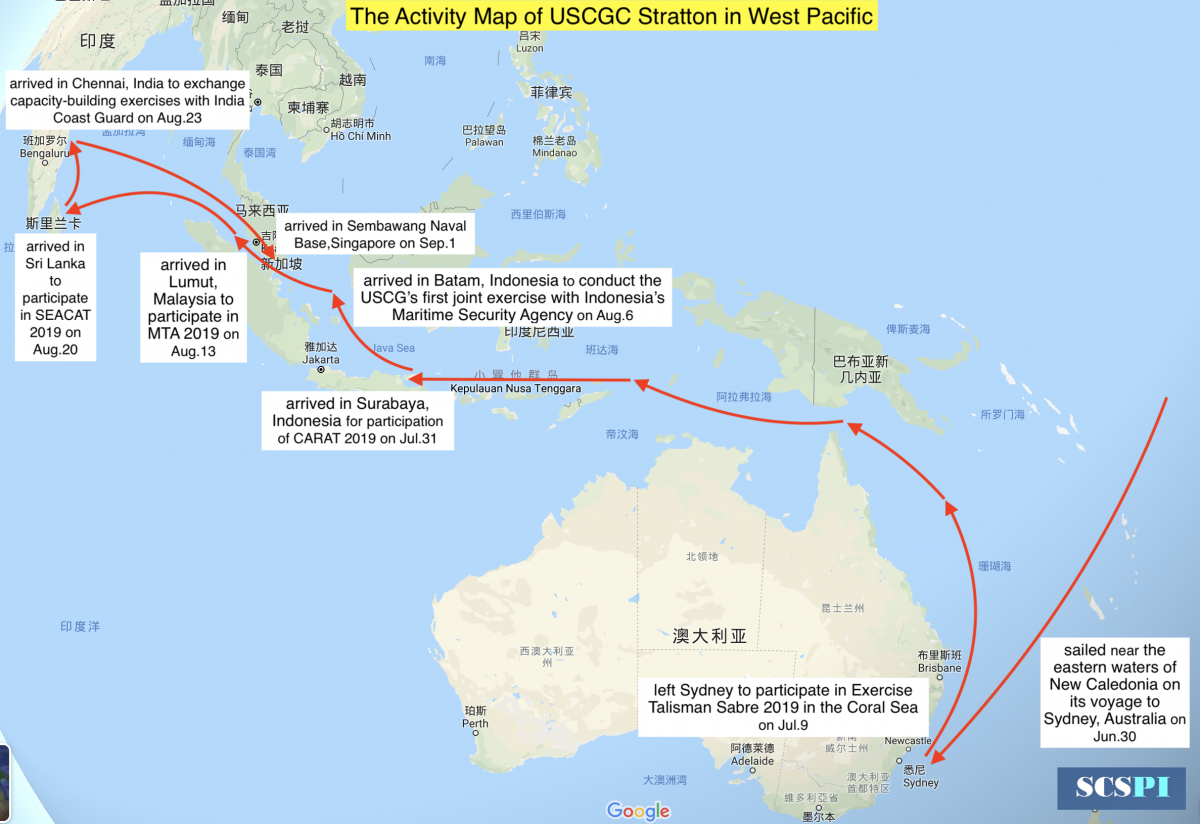
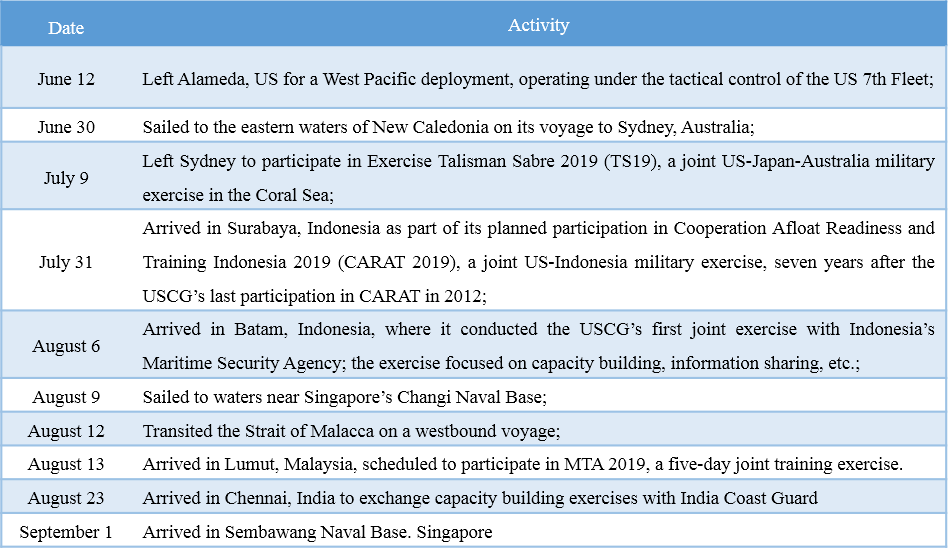
3. USCGC Mellon (WHEC 717)
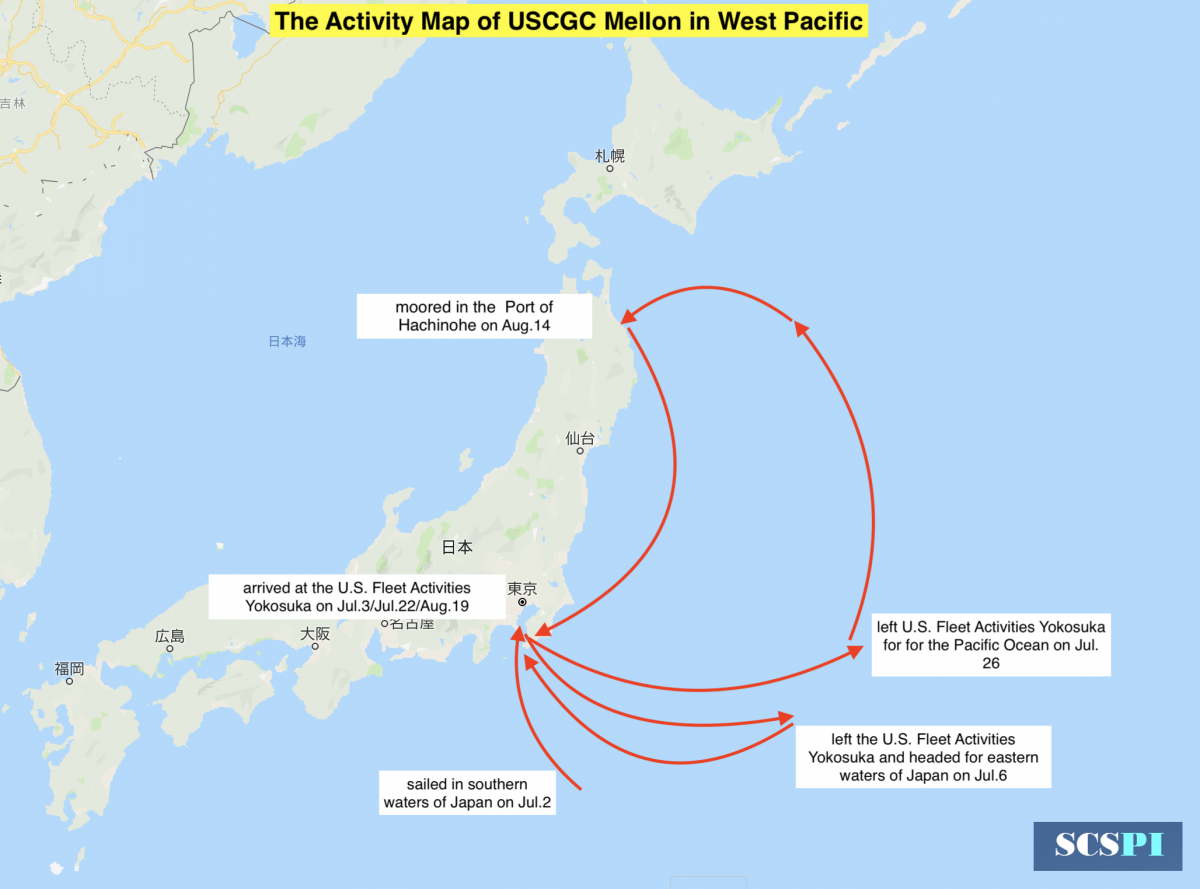

4. USCG HC-130H Maritime Patrol Aircraft (tail number 1720)

II. Characteristics of USCG’s Military Deployments to West Pacific
1. Directly under the command of the US 7th Fleet.
The USCG, different from the Coast Guard of most countries, makes up an indispensable part of the US military forces. It is administered by the US Department of Homeland Security (DHS) in peacetime, while the USN takes charge of the command during the war. Recently, the USCG forces deployed in the West Pacific arecommanded by US 7th Fleet, probably for convenience of command and logistic support.
The West Pacific is under the command of the US 7th Fleet, which is supported by a large number of naval bases in Japan, South Korea, Singapore, Philippines and Guam as well as many active logistics and supply ships. For the USCG, placing itself under the command of the US 7th Fleet allows it to use intelligence support and logistics supply in the region. More importantly, it will boost interoperability and collaboration between the USCG and warships as well as aircrafts of the US 7th Fleet, and accordingly enhance the USCG’s operation efficiency.
2. Deeply integrated into the US military combat system.
The USCGC Bertholf (WMSL 750) carried out a joint onboard aircraft takeoff and landing training near the Danjo Islands in concert with the USS Blue Ridge (LCC-19) of the US 7th Fleet during its deployment to the East China Sea. The purpose of the training was to reinforce command interoperability. Given that the USN has regularly deployed one to two guided-missile destroyers (DDGs)/ cruisers (CGs) to the Yellow Sea and the East China Sea for military operations recently, it is justifiable to suggest that the USCGC Bertholf (WMSL 750) has conducted relevant joint exercises in concert with the USN warships during its voyage in the East China Sea.
The most striking signal came from the evening of March 24 to the dawn of March 25 when the USCGC Bertholf (WMSL 750) transited through the Taiwan Strait from the south to the north in concert with the USS Curtis Wilbur (DDG 54) to conduct the first joint “routine Taiwan Strait transit” involving both the USN and the USCG. Generally speaking, Taiwan Strait transit operations need aerial intelligence support from US Naval surveillance aircrafts. For example, on April 28 and 29, while the USS Stethem (DDG 63) and the USS William P. Lawrence (DDG 110) were passing through the Taiwan Strait, a P-8A maritime patrol aircraft (tail number 169340) and an EP-3E electronic surveillance aircraft (tail number 156517) took off from the Clark Air Base in the Philippines and the Kadena Air Base in Okinawa, respectively, to offer aerial intelligence support over the southern entrance to the Strait. As these two DDGs were about to sail out of the Strait, a P-8A maritime patrol aircraft (tail number 168428) took off from the Kadena Air Base to offer aerial intelligence support over the northern entrance to the Strait. It follows that the USN might have conducted similar intelligence support operations when the USCGC Bertholf (WMSL 750) and the USS Curtis Wilbur (DDG 54) conducted the transit through the Strait. It also indicates that USCG vessels not only collaborate with USN warships on military assignments but are also capable of effectively interoperating with the latter’s aerial surveillance capabilities. This three-dimensional cooperative combat model goes a long way toward enhancing the combat capabilities of USCG vessels during their deployments to the waters.
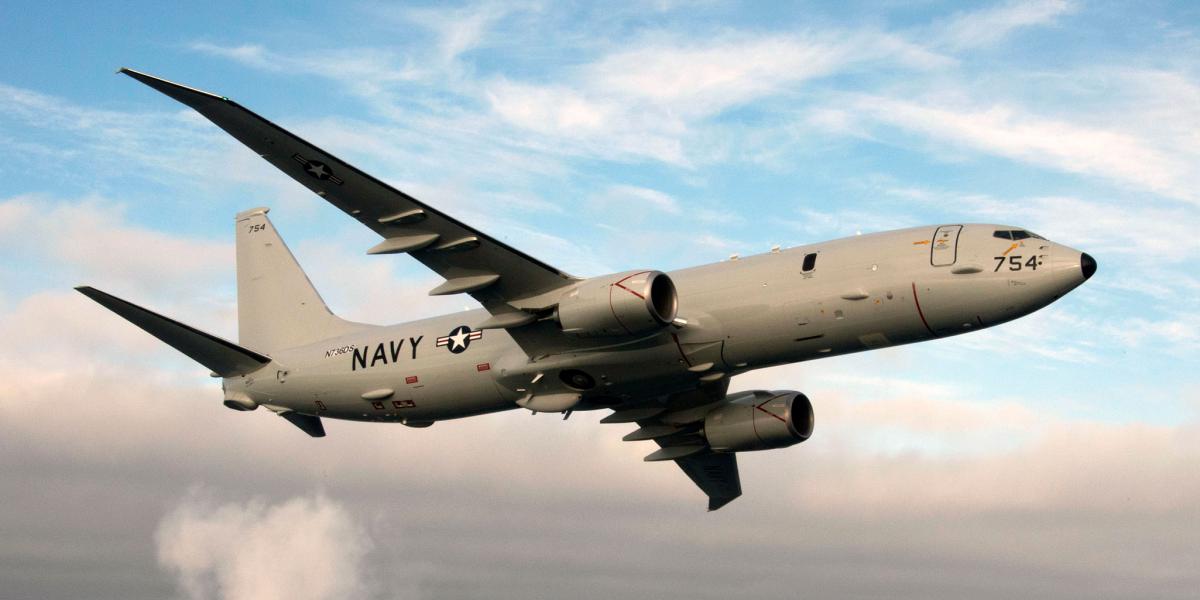
P-8A Poseidon Maritime Surveillance Aircraft, Source: www.ainonline.com
3. Continuously enhancing exchanges and cooperation with maritime enforcement units of countries in the region.
The USCGC Bertholf (WMSL 750), deployed in the first batch, conducted bilateral joint exercises and trainings successively with coast guards of South Korea and the Philippines. Having just arrived in the West Pacific region, the USCGC Stratton (WMSL 752), deployed in the second batch, participated in joint exercises and trainings with the coast guards of Indonesia and Malaysia, during which the focus was placed on capacity building, information sharing, and inter-coast guard communication and indoor programs such as a subject matter experts’ exchange (SMEE) were also launched. The USCGC Mellon (WHEC 717), also among the second batch, conducted operations for more than half a month off the east coast of Japan. It remains unclear whether the ship participated in any bilateral exercises or training with the patrol vessels of Japan Coast Guard, but the chances are high given their usual practice.
4. Proactively engaged in military soft power diplomacy.
Warships are usually considered as a nation’s mobile territory. It is a common practice for countries to demonstrate their soft power through port visits. Since the beginning of this year, the three USCG vessels deployed to the West Pacific region have visited a number of regional ports, including Yokosuka, Sasebo and Hachinohe of Japan, Hong Kong of China, Singapore, Sydney of Australia, Surabaya and Batam of Indonesia, and Lumut of Malaysia. During their visits, in addition to open house events, the crew would have engagements with people in local communities and local US embassies or consulate offices would host receptions for the crew. These moves have greatly improved the image of the USCG and virtually enhanced its regional influence.
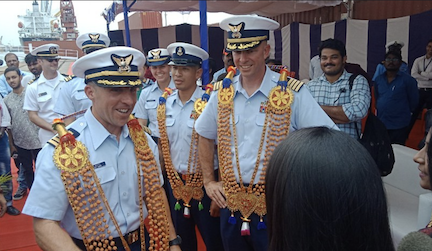
The crew of the Coast Guard Cutter Stratton (WMSL 752) departed from Chennai after a multi-day engagement with the Indian coast guard, Source: www.uscg.mil
III. Aims and Intentions of USCG Deployments to the West Pacific
1. To address challenges of the so-called “gray zone.”
In recent years, the US has been accusing China of practicing “gray-zone” tactics by leveraging coast guards and maritime militia in waters such as the South China Sea and therefore posing severe threats to US military operations. Compared with naval forces, coast guards can handle “gray-zone” issues more flexibly. Therefore, by deploying USCG vessels to the West Pacific region, the US seems to be beating China at its own game, namely to confront the “gray zone” of countries such as China with its own and provoke military-to-military and coastguard-to-coastguard confrontations with China in full swing in the South China Sea. Moreover, as USCG vessels deal with both civilian and military concerns, they show more professionalism and flexibility than naval ships, while responding to threats of the so-called “maritime militia.” The first stop of the USCGC Stratton (WMSL 752) was Australia, where it participated in the US-Japan-Australia TS19 joint excise, and then it arrived in Indonesia for CARAT 2019 and Malaysia for MTA 2019. Seemingly stoked, the USCG is sending a message that it can operate in the region as an equal to the USN. This means that the US has significantly enhanced the role of the USCG in potential regional military conflicts and confrontations.
2. To tackle North Korea’s maritime smuggling.
On November 29, 2017, North Korea announced that it had successfully tested an intercontinental ballistic missile named Hwasong-15, and claimed that the missile could carry a large nuclear warhead far enough to strike any part of the US mainland. Since then, the US has begun using “North Korea’s threat to US national security” as a pretext for launching a series of countermeasures. It first incited the United Nations to enforce embargos and sanctions against North Korea, and, at the same time, introduced a set of domestic sanctions on North Korean businesses and individuals. Meanwhile, the US goaded its allies and partners to join it in deploying various forces including aircrafts and ships to the East China Sea and the Yellow Sea to supervise sanctions against North Korea. During the West Pacific deployments of the USCGC Bertholf (WMSL 750), it spent much time navigating in the East China Sea, so its major task was presumably to monitor North Korea’s illegal smuggling activities.
3. To relieve the insufficient forces of the US 7th Fleet.
After two collisions in 2017, the DDGs USS John S. McCain and USS Fitzgerald have been paralyzed, and another DDG USS Barry has been undergoing ongoing repairs in the dock, which makes the forces of the US 7th Fleet inadequate. Moreover, in the wake of the collisions, the US 7th Fleet and the entire USN have been conducting a major overhaul in terms of crew exercises, trainings and appraisals, which heavily handicaps the capacity of warships at the U.S. Fleet Activities Yokosuka for operations outside ports. The USCG could help take on some responsibilities and execute operations of the USN in the region for some time, which is apparently true given that the USN indeed decreased its deployments in the South China Sea while the USCG was engaged in operations in the region.
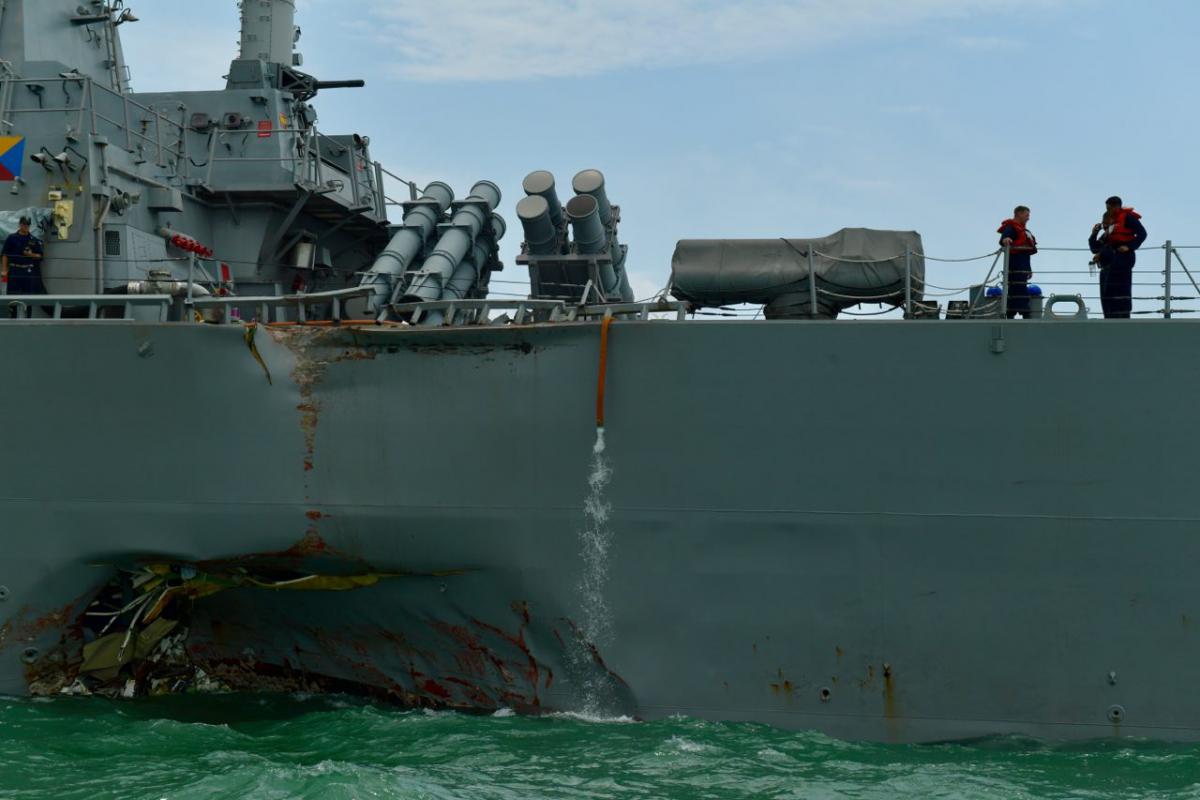
the US Navy destroyer USS Fitzgerald collided with MV ACX Crystalm 2017, Source: news.sina.com.cn
4. To enhance the ability and role of the USCGin the West Pacific.
It is not new to see USCG vessels carrying out overseas military tasks together with the USN. For instance, in 2008, the USCG deployed six vessels to Bahrain, a state situated in the Persian Gulf, for patrol missions as part of Combined Task Force (CTF) 158. The USCGC Mellon (WHEC 717) deployed to Japan has just concluded its fisheries enforcement operations in the South Pacific region in February,2019 and returned to the US. In May, amid the tensions in Venezuela, the USCGC James was deployed to the open waters of the country for patrol and reconnaissance missions. Therefore, one important reason for the West Pacific deployments of USCG vessels is that, by sending such vessels on various assignments and exercises in the region, the US can familiarize them with regional operational environments and boost their capacity to execute tasks in the West Pacific region. "In today's complex geostrategic environment with rising great power competition, the importance and demand for a strong Coast Guard presence in the Pacific has never been greater," said Coast Guard Commandant Adm. Karl Schultz.
Conclusions and Outlook
Given the aforementioned illustrations, it is believed that the USCG has been long considering intervening in the South China Sea issue. In 2017, there were intensive discussions and preparations in this regard in the US. “I have discussed with the CNO (Chief of Naval Operations) the concept that we would create a permanent USCG presence in the South China Sea and related areas,” said Frederick Zukunft, the then USCG Commandant in an interview in January 2017. “This would allow us to expand our working relationship with Vietnam, the Philippines, and Japan. We can spearhead work with allies on freedom of navigation exercises as well.” Meanwhile, in early 2017, the Center for International Maritime Security (CIMSEC) published a report on the USCG deployment to the South China Sea, in which it concluded that, it is entirely possible that the introduction of USCG assets, deployed to the South China Sea area of operations, will result in positive results in the form of increased capabilities and support of US FONOPs, and USCG vessels, as public service ships, will relieve tensions in a conflicted milieu of the region. However, there is also a possibility that USCG forces may become embroiled in actual conflict in the area. Therefore, a comprehensive risk analysis should be undertaken before any USCG deployment to the region and the mission should be considered a “go” only if the benefits heavily outweigh the costs.
On the surface, the USCG features weaker firepower and is thus helpful in neutralizing sensitivity. In effect, however, it is more likely to trigger further escalation of tensions. Moreover, different than warships, coast guard vessels are deployed partly for law enforcement, which means that their deployments will inevitably facilitate the direct intervention of the US in the South China Sea dispute. The US is certainly aware of this point, but in order to target China in the South China Sea in a more comprehensive and solid manner, it takes risks in evidently upping the ante in the region. But the effects of its moves remain to be seen. Due to factors like budget restraints, the USCG simply does not have the capacity to carry out large-scale overseas deployments. Vessels with a displacement of 4,500 tons, like the USCGC Bertholf and the Stratton, are the most technologically advanced ships in service. Thus, the deployment has only a tiny bit of influence on US military presence in the South China Sea. On top of that, the excessively high risks may not eventually pay off.

